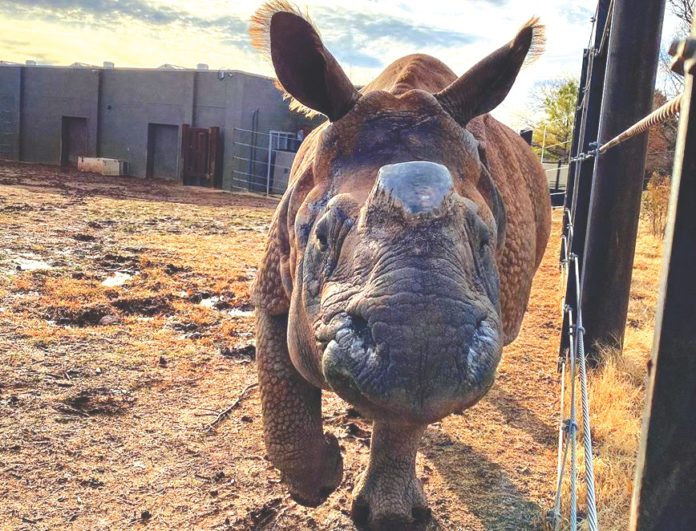Indian rhino calf due this fall – Zoo is committed to conserving this rare species
The Oklahoma City Zoo and Botanical Garden is proud to announce that its female Indian rhinoceros, Niki, is eating for two! Niki, 13, one of the OKC Zoo’s adult, female Indian rhinos–also known as the greater one-horned rhino–is expecting a calf with the Zoo’s male, Indian rhino, Arun, 29. This will be the first offspring for this breeding pair.
“Rhino births are significant events at the Zoo so we are thrilled to share news of Niki’s pregnancy and cannot wait to welcome this new addition to our herd,” said Rachel Emory, OKC Zoo curator of pachyderms. “The Zoo is committed to the conservation of this amazing species and recognizes the vital role this calf plays in helping ensure our world’s rhino populations survive for future generations.”
The Zoo’s veterinary team confirmed Niki’s pregnancy through hormone monitoring and ultrasounds. She is expected to give birth late October or early November 2020 following an approximately 16-month gestation. This will be Niki’s second offspring to be born at the Zoo and the sixth Indian rhino birth since the species became part of the Zoo’s animal population in 1981. Niki’s first calf, a male, Rupert, born in 2014, now resides at Mesker Park Zoo in Evansville, Indiana.
Rhino dad, Arun, arrived at the Zoo in February 2019 from the Fort Worth Zoo as part of a breeding recommendation by the greater one-horned rhinoceros species survival plan (SSP). SSP programs were developed by the Association of Zoos and Aquariums (AZA) to oversee breeding management and sustainability of select animal species within AZA-member zoos and aquariums. The Zoo’s Sanctuary Asia is also home to adult, female Indian rhino, Shanti, 32 who also came from the Fort Worth Zoo with Arun.
At almost 4,000 pounds, Niki appears healthy and her pregnancy is going well. She is receiving excellent care and attention from her caretakers who are working closely with the Zoo’s veterinary team to monitor both mom and calf through ongoing exams and ultrasounds. Caretakers have been working with Niki through positive reinforcement training to ensure she is comfortable with these exams and voluntarily participating in her care.
Native to northern India and southern Nepal, Indian rhinos are currently listed as “vulnerable” by the International Union for the Conservation of Nature. Through conservation programs, wild populations over the past century have recovered from under 200 animals to approximately 3,600 today. However, there is a continuing decline in the quality of their natural habitat and the species continues to be illegally hunted for its horn.
The OKC Zoo is helping save Indian rhinos by supporting the International Rhino Foundation’s efforts to protect vulnerable and critically endangered rhinos and their habitat in India with money from the Round Up for Conservation Fund. The Zoo’s Round Up for Conservation program encourages guests to donate their change from any Zoo purchase to help protect wildlife and wild places around the world. Plus, the Zoo’s American Association of Zookeepers chapter has raised more than $373,000 for rhinos in Asia and Africa through its fundraising efforts since 1990.
Stay in the rhi-KNOW and follow the Zoo on Facebook, Twitter and Instagram and by visiting Our Stories for updates on Niki and her little one on the way!
The Oklahoma City Zoo is located at the crossroads of I-44 and I-35 in the heart of Oklahoma City’s Adventure District and is a proud member of the Association of Zoos and Aquariums, the American Alliance of Museums and an Adventure Road partner. Hours of operation are 9 a.m. to 5 p.m. daily. Regular Zoo admission is $12 for adults and $9 for children ages 3-11 and seniors ages 65 and over. Children two and under are admitted free. Zoo fans can support the OKC Zoo by becoming Oklahoma Zoological Society members at ZOOfriends.org or in-person at the Zoo. To learn more about these and other happenings, call (405) 424-3344 or visiting okczoo.org.















